 |
| Severn Estuary |
I live in Filton, north Bristol. I regularly visit the Severn Estuary coast, particularly New Passage, Pilning Wetlands and Aust just north of Severn Beach; Oldbury Power Station and Shepperdine further up the estuary; and the Marshfield area of the Cotswolds north of Bath
Two events affected my year: the ongoing flood defense works along the Severn Estuary from Aust downwards, preventing us birdwatchers from accessing some of our favourite sites... And Covid restrictions preventing trips at home and abroad… But we carry on and find interest where we may
Please excuse long lists, particularly of plants – my enthusiasms getting the better of me!
January
Fog-watch: I ventured out to New Passage on the Estuary in frost, freeze & fog - which made it a ‘fog-watch’ as much as a bird-watch - but so still, quiet & lovely…
Cryptochromes: I was sent an article on a recent breakthrough in understanding vertebrates’ abilities to detect the Earth’s magnetic field, especially relating to orientation. Previously the only substance known to respond to magnetism in animal bodies was magnetite - a naturally magnetic form of iron found in some birds’ heads, for instance. However researchers recently found that cryptochromes - particular proteins within vertebrate cells - also respond by ‘dimming’ in the presence of a magnetic field (there seems an analogy to chlorophyll molecules in plants where incoming light photons can ‘bounce’ electrons from a lower to a higher atomic shell for energy reuse); but how cryptochromes work seems more complex, and little understood as yet…
 |
| Crossing... |
 |
| Pollarded... |
There was a wild-animal crossing evident each side of the large rhine – and deer certainly use it as you can see their slot marks!
These willows with very thick pollarded bases must surely have some age to them…
 |
| PiedWagtail NaturalEngland |
Pied Wagtail’s gait: Sitting in my car at Aust Services, I’ve have spent time watching the local Pied Wagtails and marvelling at their gait: they walk rapidly, and then scurry at such tremendous speed that they almost seem to float… before walking again. This 'scurry' is, to the naked eye, completely smooth... I tried to see if anyone has studied this, or done a slow-motion recording, but without success, but a bird friend suggested: ‘Their feeding behaviour is consistent with their gait: emerging low level insects form much of their food, hence, a very floating stable gait helps capture.’ I also mentioned their chicken-like back-&-forth head movements, not necessarily when they wag their tails, and he replied: ‘Head movement in birds is often a mechanism for judging distance as (ususally) their eyes are fixed in their sockets and can’t move as ours do’.... I thought that was the most rational explanation I’d heard - ‘and chickens get mocked for appearing rather daft as a result!’ He continued: ‘If you watch any raptor sitting prior to taking flight and pursuing prey, they will often bob their head as well as moving it from side to side. In this way they get an accurate initial ‘fix’ on their intended preys’ location. Their eyes are, relatively speaking, very large and cannot move in the sockets...’
 |
| 'Saltmarsh' |
Saltmarsh 1: I’ve started reading my Xmas present, 'Saltmarsh' by Clive Chatters (2017) in the Bloomsbury ‘The British Wildlife Collection’ series. It's very fascinating, and also makes me realise how much I do love saltmarsh areas - because I know so many of the places he talks about! And also know so many of the plants mentioned (thanks to many botanical outings)! Obviously living along Severnside is a great bonus...
Reckless: The 'Saltmarsh - Far from shore' chapter about road-salt loving plants and their pursuers, says: 'The expectation of fresh discoveries has stimulated botanists into acts of daring-do with reckless accounts of forays along trunk roads. What was once frustrating congestion is now an opportunity to inspect, if not access, the sanctums of central reservations and hard shoulders.' I sent this to our Botany leader, who is a great one for ‘reckless forays’ on the motorway!
Scooter & Fag: I spied a very ‘Viz’-cartoon-type character down our road: an extremely tough-faced older woman riding a (non-disabled) scooter down Northville Road with a lit fag sticking out her mouth…
Severn Bridge in lockdown: - Walking across the Old Severn Bridge I encountered two smiley teenage girls on the way out and again as I returned. I asked if they’d walked all the way from Wales - yes, they said, they live in Chepstow and ‘it’s something to do’. Well done them! - that’s a goodly walk of some miles…
Bridge vertigo: For the first time I noticed small round grids at intervals in the bridge footway – what were they for? I finally looked directly down one, and experienced a vertigo-induced ‘squeak!’ - for they opened directly into the forty-plus metre void beneath to a view of the churning cocoa-coloured Severn…
B & W: In Aust Services carpark, a Magpie was persistently driving a resident Pied Wagtail from some scraps - it was Big Black & White versus Little Black & White!
 |
| Apples... |
 |
| Wrack |
At Aust:A wealth of tiny red fallen apples... A variety of fungi on a log and growing along the grain of the wood... And some very large seaweed bladders: a colleague ID’d these as Egg Wrack, Ascophyllum nodosum, which only grows in the northern Atlantic, on sheltered shores...
Saltmarsh 2: I finished ‘Saltmarsh’ by Clive Chatters. It is both a comprehensive yet idiosyncratic book on their history, ecology, loss and growth, and conservation; saltmarshes within Avon, Gloucester, South Wales and Somerset feature. One of the issues that interested me most was that, within recent paleontological and into archaeological time to the Neolithic, large herds of large wild herbivores grazed the British Isles – red deer, aurochs, elk - as well as huge flocks of grazing wildfowl. Their influence meant that aboriginal Britain wasn’t as wooded as some re-wilders seem to think, but had zoologically-created meadows, downs and glades - and short-trimmed saltmarshes where animals enjoyed the nutritious and tasty herbage. Then during the Neolithic, most large herbivores were gradually replaced by domesticated cattle and other domesticated animals which took over the positions of maintaining Britain’s open pastures (though the last aurochs only died out in Poland in the C17th!). Rewilders need to bear in mind this vital aspect of maintaining our varied ecology...
 |
| Auroch skeleton Malene Thyssen |
Another tough character: When I get a coffee at Aust Services I’m often served by another scowling tough-faced older woman who doesn’t make eye contact, doesn’t smile and doesn’t speak beyond the utter minimum. However just now she was serving a handsome lorry driver ahead of me - and was full of smiles and banter! I felt most annoyed...
Stoneworts: I have only recently discovered Stoneworts (Chara) - algae that look like water plants and I still can't get my head around how algae can form such complex organisms! One botanist said, ‘The particularly remarkable thing about Chara and its like is that the stems include cells that can be 10cm long, so you can watch the cytoplasm circulating through a microscope...’ Another said, ‘Stoneworts have emerged as rather a thrill both in the field and under the microscope.’
 |
| Stonewort |
Lomentaceous: I enjoy banter and wordplay with my Chara friend above, who let me know that: ‘I've just learnt the word 'lomentaceous' from the brown seaweeds flora I'm editing.’ For the full Wiki definition of a Loment: ‘a type of dehiscent legume fruit that breaks apart at constrictions occurring between segments, so that each segment contains one seed. It is a type of schizocarp.’ Now you know!
Leopard's-bane: I’ve just been reading about the handsome wild plant Leopard's-bane. We still have some self-sown in our back garden – and true to its name, we've never been troubled by a Leopard yet...
Paddling: At our local large shopping centre I video-ed these two Herring Gulls paddling for worms - – always an irresistable sight!
Premonition: The sun had gone down after a beautiful sunset at Aust Wharf, and it was dark dusk at the Services when I’d got a coffee and sat in the car. The small trees each side of the main entrance were full of about 150 roosting Pied Wagtails gently chingling, and gradually all agglomerating into just a single tree... And then it snowed that night - did the wagtails know ahead of time, and gather there where it was safer, warmer, and with food available?
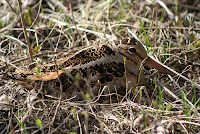 |
| Woodcock flickrfavourites |
Woodcock caught in flight: There was a wonderful photo on our local bird Blog, of a Woodcock surprised in flight and at close quarters. How the photographer managed that I don’t know, as Woodcocks are notorious for holding their nerve and staying hidden on the ground till your foot is almost on them, then taking off at high speed and disappearing before you know it...


Snow: It started to snow... I went down to Aust Wharf just to enjoy the peace of it falling over the saltmarsh and estuary…
February
Ravens: At our local retail centre, a pair of Ravens suddenly dropped from the sky onto the car park as I was driving in - so big, hook-beaked and shaggy - then dashed a few metres further on, had a brief tussle and flew off again… awesome!
 |
| Bison Kewing |
Rewilding – a step too far? We continue to discuss the concepts of Rewilding. The more extreme versions would hope to re-introduce large grazers like Bison, but we agreed this is probably not recommended for small reserves like the long thin strip of local Bradley Stoke’s Three Brooks Reserve, which sits in the middle of housing! It would be a step too far... in fact a couple of steps and they'd be trudging the back streets of Bradley Stoke...
 |
| Creeping Buttercup |
Easter Compton to Compton Greenfield: Today I and a friend took a walk round Easter Compton, Dyers Common & Compton Greenfield (in from the Estuary and industrial Avonmouth). Last year a completely new interchange was built on the M49 there, to access new developments in Dyers Common industrial estate, with massive new embankments, huge steep earth-filled grass-faced gabions, lots of scruffy new planting (willows, hawthorn, alder), a new lake (Mute Swan, Tufted Ducks, Mallard & Coots there), and small scruffy ponds. But it might house interesting plants come the Spring – we saw flowering Creeping Buttercup, Field Pansy and Common Vetch.
 |
| Mistletoe |
In the adjacent little hamlet of Compton Greenfield we saw this wonderful example of male and female Mistletoe side by side - I hadn't realised the brighter yellow was always the male! Nearby Moorhens pottered near a small stream, a Blackbird and Song Thrushes sang (one so strangely it was almost unrecognizable, with imitations of a gull or buzzard…), and a Mistle Thrush sat high in a tree...
Dyers Common: We expanded our previous walk onto an established (but unknown to me) bridle path that wends north through Dyers Common industrial estate. To our surprise this went through rough open land, small woodland and grassy rides along rhines - like proper country and full of interesting birds (even on this icy day), yet threaded amongst massive industrial developments! There was a Little Grebe on one of the new lakes, a Kestrel hunting where Skylarks and Meadow Pipits flew round the rough grass, a Kingfisher flashing along a rhine with Mallards and Moorhen and a Cetti’s Warbler calling, a Swan breaking through the thin ice of another lake as it circled round to feed, and a pair of Stonechats sitting on adjacent post along a ride where Bullfinches called and flew...
Frogspawn: My inner-city friend reported that her frogs are mating and calling and laying frogspawn, though the weather continues bitterly cold...
Nailsea Moor: - Lesser Celandine flowering.
- Hemlock Water Dropwort and Fool’s Watercress, which must have a completely submerged early/overwintering leaf form, visible all along the shallow river bed.
 |
| Turkey Tail |
- A fine stump stand of Turkey Tail fungi - our expert says the striking green-coloured bands are made by algae in a semi-symbiotic relationship with the fungus...
- 'Leks' of Water Beetles scudding around the river surface - their wing casings a brilliantly reflective shiny black.
- A big flock of Lapwings constantly wheeling over the moors – we wondered about the energy expenditure, but it’s a strategy that obviously works for them…
‘Pest Control’: A while ago I noticed the large Royal Mail sorting office on the A38 Filton Airfield, had completely netted off its flat roofs – roofs that are popular with breeding gulls. I alerted our Gull expert who said: ‘Yes, that netting is new. Even during the Covid restrictions, the pest control industry is making good money… The wrong mesh size will, inevitably, trap and slowly kill the gulls…’
 |
| Lapwing |
Lone Lapwing: I spotted a lone Lapwing on a roundabout of the new road system running through the redeveloping Filton Airfield near my home. It was strange seeing such a wild bird marooned like that – it must be young or injured and surely can’t last long there?
(Apparently this same new roundabout had several Bee Orchids in flower last May...)
A Portal to the World of Moths: A naturalist friend had reviewed ‘British Moths: a Gateway Guide’ by James Lowen. He had made this complex subject dealing with thousands of species - sound quite wonderful and accessible! It encouraged me to buy it, as it seemed to understand the problems of us novices standing utterly daunted and bewildered at the ‘Moth-land portals’...
Milder Rewilding: A BRISAW member wrote on Rewilding that she ‘…feels the focus should be on mitigating post-1970s intensive farming, and - in the right places - increasing tree cover. (But the right tree(s) in the right places! Butterfly Conservation, and others, are concerned about trees being put in willynilly on unimproved grassland, a habitat which as we know is itself getting rarer...)’ I think this response has much to recommend it, and I shall be adopting it!
 |
| My Camera |
My Camera struggles: A year ago I bought an ultra-compact lightweight camera with sufficient zoom to get decent close-ups of birds. I struggled hard to get to grips with all the new and fiddly technology, but with no-one allowed to get close to help me, I fell at many a hurdle and eventually gave up on in despair at not being able to resolve some basic issues. However this year I got it out of its drawer again, and a friend who is a fine bird photographer helped me sufficiently (plus online tutorials) to finally enable me to take some photos. But he ended his latest message with this gloomy sentence: 'Photography is a real pain no matter how good your kit is.’
Sexing Finches: I enjoyed a piece in our Birding newsletter, about the difficulties of sexing Goldfinches and Goldcrests - I think I'll give it a miss for now!
More Awkley: A walk in our ‘South Glos levels’ below Almondsbury which turned into a lovely Spring day - I literally think the Hawthorne leaves opened during our few hours out! Flowering Red Dead-nettle… Deer slots…
 |
| Field Speedwell D Bowring |
Blue: A friend posted a photo of a flowering Field Speedwell (Veronica persica). I told him, ‘I just opened your Speedwell photo up full size - to bask in the blue!’ He replied: ‘Gotta value a Veronica…’
 |
| Newt |
Pool: Friends have a chalet in Tickenham Ridge woods inland from Clevedon. Their forestry neighbours have a spring-fed pool in adjacent woods where we saw a Newt and frogspawn (the more cloudy-looking blue areas in the photo)... And extra-long catkins blowing in the breeze…
 |
| Catkins |
Mandarin Ducks: On a walk on Tickenham Ridge we passed Naish House above Clapton in Gordano, which has an adjacent wooded lake with lots of water birds. These included three Mandarin Ducks, which when I submitted to our bird blog, was told were a 'red letter' or uncommon species in Avon. Looking at the Avon Bird Report and hearing from other bird watchers, I can see how patchy sightings of them are, and can see a similarity in sites they've been recorded – mostly secluded wooded lakes and small rivers…
 |
| Mandarins |
When I was young and would see Mandarins on municipal lakes, I always assumed they were ‘tame’ birds put there by the parks department – it was only relatively recently that I realised they could lead their own wild existence!
March
 |
| Redpolls |
Redpolls: Look at this lucky member of our wildlife group, who has Redpolls coming to her feeder... You feel like you want to give these beautiful birds a lovely cuddle!

 |
| Cretaegus |
- These ornamental Cretaegus (Hawthorn) trees held their abundant big berries right through the winter, so obviously they weren’t the first choice of the Winter Thrushes – but now the berries have been severely depleted. You can still see Winter Thrushes in large numbers in the right spots, and they must still be looking for food here…
 |
| Teal |
Photo success: Here are the first halfway-decent photos I have taken with my new micro zoom camera - allowing for windiness, distance, camera shake, and the limitations of such a small camera - a Black-tailed Godwit and a Teal at New Passage. The latter was deemed good enough to grace that day’s Avon bird blog, so I must be getting somewhere...
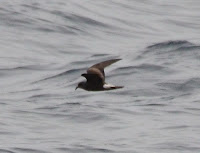 |
| Leach's Storm Petrel Loarie |
 |
| Backswimmer |
Backswimmers: A friend put photos of these beautiful insects on our wildlife site – and I’ve never even heard of the genus! They looks so like an 'art' brooch from 100 or so years ago, made of tortoiseshell and bronze with jasper eyes... yet can be found in our local ponds!
Coltsfoot: Coltsfoot in scattered swathes at the base of Aust Cliff...
 |
| Coltsfoot |
The Vegetative Key to the British Flora: A friend has lent me the famous ‘The Vegetative Key to the British Flora’ by John Poland, and I have spent some time getting acquainted. What stuns me is, he was only 30 when it was published, and he'd only had seven years since he graduated to produce it. And he is also a bird, reptile and amphibian enthusiast (which probably means an expert for the whole British Isles...) as well as working full time! Imagine getting that amount of expertise for every plant in every season in every part of the British Isles - I suppose he started getting his eye in very young - and has had lots of help?
 |
| Adder |
Mendip Adders: A wildlife group member who lives near the Mendips, reported on Adders there with some fabulous photos...
Royal Mail Gull update: I updated our Gull expert on the situation at the Royal Mail building: ‘The gulls at the A38 Royal Mail just love that building in spite of the netting! They always seem to be cruising overhead, and there are many sitting (in pairs or singly) along the parapets, so I guess there are still nesting opportunities just outside the netting? I haven't spotted any casualties yet, but my views are almost entirely only from a moving car…’ He said, ‘If the gulls do breed on either of those roofs, there will certainly be casualties – if not adults, then nestlings…’
 |
| Penduline Tit Mike Moxon |
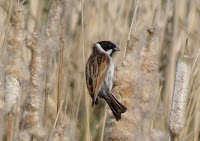 |
| Reed Bunting |
I have only seen Penduline Tits once before, in Herzegovina/Croatia where we saw a beautiful male foraging for nesting material in undergrowth near a large river, and taking it to his lovely suspended hidden nest…
 |
| Weld |
Plants at Weston Airfield: This brownfield site has lots of rhines, reed beds and small lakes, and large areas of damp shallow lagoon bordered by raised bare earth embankments. On one stretch of the latter was an extensive swathe of scattered Wintercress interspersed with Weld, and very little else (the unopened Wintercress flower heads looking very tasty) - both plants liking waste and brownfield sites...
Some dye facts: The whole plant of Weld or Dyer’s Rocket makes a yellow dye; mixed with blue from the leaves of Woad it made the green dye Lincoln Green – supposed to have coloured Robin Hood and his Merry Men’s clothes! The yellow flowers of Dyer’s Greenwood make a yellow dye that was grown commercially into the 20th century; mixed with Woad it made the green dye Kendal Green for a green cloth historically worn by foresters!
 |
| Stock Dove Keith Laverack |
New Passage & Pilning Wetlands: Bright with a fierce southerly wind! I walked round the back of the pools to the east end of the side lane. There were Sand Martins and Swallows – my earliest ever Swallow… (though last year I saw a few Sand Martins on 22 March…) Three Little Ringed Plover on the saltmarsh… And a treat to see six Stock Dove pottering in a field with sheep and lambs on my return…
 |
| Avocets |
Photographing Avocets: I went to Aust for the Avocets that have been seen on the estuary foreshore there. The security fencing guarding the new embankment works gets fiercer and fiercer, so I endured some rather hair-raising escapades to access the pill and foreshore – including setting off a small security tower that bleeped blue and white lights and shouted ‘Your presence has been detected! The owner has been informed!’ In the end I walked from the old ferry line along the salt marsh to the mouth of the pill – and there were the four Avocets on the shoreline below. And I managed to take some bearable photos of them with my new micro camera…
 |
| Severn Bore Phil Champion |
The Severn Bore: We went to see the Severn Bore - the phenomenon where this river with the second highest tides in the world, on the astronomical highest tides of the year, forms a single or multiple wave rushing upstream as the river narrows. We went to Epney quite far up the estuary, on a beautiful quiet Spring morning with the river still… Then I could see a white-edged wave coming round the bend, a deep roar, and spray flying up the banks where 16 surfers waited… It differed from previous bores I’ve seen which were solid walls of water bearing upstream with very little breaking - this one had a full surf-style curling front wave and two or three more behind… The river raced upstream at 5 mph or more, and carried on at this speed for nearly an hour... the strongly turbulent water forming patterns like tree bark…
Sand Martins at Epney: Just below the Epney pub, the river embankment becomes a high vertical retaining wall, where about fifteen Sand Martins were constantly flying to and fro. I couldn’t see what attracted them – perhaps some insect life, as I could see no obvious place for nesting? But those knowing better said they may well have been scouting for areas suitable for excavating, and there were probably drainage holes providing suitable nesting sites…
April
Botany at Dyer’s Common: We returned with our botanist, hoping for some interesting spring plants on the great areas of new embankment along the new M49 Junction, but mostly it looked sadly drab and poor. Growth on the over-steep earth gabion embankments is dying rather than thriving, and the small pools look polluted and stagnant… I do hope that nature will fight back in time. But we did find Stone Parsley, Wood Dock, Greater Pond Sedge, False Fox Sedge, Common Figwort, Melilot, Lesser Swinecress, White Stonecrop, Thale Cress, Round-leaved Crane’s-bill, Common Whitlow Grass, Long-pod Willowherb, Hairy-leaved Spurge, Viper’s Bugloss, Sanfoin, Thyme-leaved Speedwell, Swinecress, Wild Pansy, Kingcup, Sweet Vernal grass, Musk Stork’s-bill and Pink Water-speedwell… and Stonewort.
Back-door Fox: A young-looking fox came fossicking right to our back door – it looked rather poorly with an almost hairless tail…
Pilning Wetlands: From the side lane we had good views over much of the pools – and lots to see! - Godwits in a lovely range of ‘turning to summer plumage’ rusts and brick reds with great variety in their back patterning… Little Ringed Plovers scampering all over… Great swooping bands of Swallow, Sand & House Martins…Lots of pretty Gadwalls… Snipe lurking in the reed edgings, feeding busily… Jolly Little Grebes catching little fishes… A Canada Goose on a nest, head held low… An exquisitely yellow Yellow Wagtail… Blackcaps singing… Enticing possibility that a Pipit with a heavy bill was a Water Pipit... Whitethroats in the hedgerows… Two flying Stock Doves, and a bright Wheatear on the saltmarsh.
Crouched Swans: Passing fields early in the morning along the M5 motorway just north of Weston-s-Mare, I saw fifteen Mute Swans settled so low in the grass I thought their just-visible white heads were gulls…! Apparently they crouch low like this to conserve heat while they’re sleeping...
 |
| Angle Shades Moth |
Angle Shades Moth: One of our wildlife group members (G Hardman) posted a beautiful photo of an Angle Shades Moth. The Butterfly Conservation group says, ‘An unmistakeable and distinctive moth with pinkish-brown markings. The wings are folded along the body at rest which gives the impression of a withered autumn leaf.’
Sand Point: A bird trip to this stony headland thrust into the Bristol Channel north of Weston, and adjacent river estuary, fields and orchards. We saw Common Redstarts which are still migrating at this time of year - coming out of low shrubbery overhanging fencing to hunt along the fence line and dart back in again...
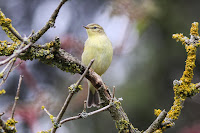 |
| Willow Warbler Ron Knight |
Chiffchaffs and Willow Warblers adjacent! Here are some distinguishing traits, aside from song, to tell them apart: Willows are more olivey-above yellowy-below than the greyer-above paler-below Chiffs. They have paler legs and longer wings as seen when perched (the primaries projecting further back), while Chiffs have dark legs & shorter wings when perched. And when feeding amongst leaves, the Chiffs almost always dip their tail repeatedly while Willows rarely do...
One Common Gull amongst a large flock of Herring and Lesser Black Backs… Skylarks and Meadow Pipits… a probable Tree Pipit (whose markings should look noticeably stronger and more definite than the commoner Meadow Pipit) and Rock Pipit… Singing Blackcaps… Greenfinch and Chaffinch… We could have seen Ring Ouzel & Pied Flycatcher… and Whimbrel are expected any day…
Flowering Scurvy Grass on the south-west flanks where it would get salted by sea spray for the salt it likes… and tiny grazed Common Storks-bill, and Early Forget-me-not which likes warm limestone slopes...
The Quick-release Vest: I have ‘invented’ a very handy garment - the quick-release vest. On cold early morning walks the vest gets pulled on like a tube without the shoulder straps – but as the day warms I can discreetly pull it back down and off without removing any other clothes! I revealed the concept to one of my walking friends and told her that ‘The quick-release vest showed its versatility on a VERY chilly walk at Sand Point today - added surreptitiously in the car park before the start, and then released to the hips near the warmer end, in motion whilst walking!’
Open-air Pilates: I’ve been attending some open-air Pilates classes in the beautiful gardens of an old rectory outside Bristol, full of large trees and abundant birds… Today we had a Great Spotted Woodpecker hammering very loudly in a large oak just above our heads – it was selecting a variety of branches to achieve a variety of tones...
 |
| Shelduck tracks |
Shelduck & Rabbit Holes: At Oldbury Power Station, the local Shelducks often leave a wonderful pattern of footprints in the estuary mud fronting the main buildings. I wondered if they nested nearby, and the local expert told me they often nest in rabbit burrows, including any ones along this shore.
There were lush Cowslips, and Kingcups and Bogbean on the hidden pond… And abundant St Mark’s Flies flying – though the actual saint’s day is 25 April, so a tad early this year!
Dandelions: Like this Spring’s Blackthorn blossom, we are now having a wonderful Dandelion year. I like the way they colonise and blossom forth from every scrappy corner… though obviously they are a pain for gardeners! The central reservations on short stretch of nearby dual carriageway usually have tremendous early displays of solid yellow edge-to-edge blooms. I wanted to take photos but it’s hard to pull in, so I thought ‘I’ll come back tomorrow’… But on my return they’d all been mown flat!
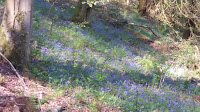 |
| Bluebell carpets |
 |
| Wych Elm flowering |
Botany at Leigh Woods: In this woodland nature reserve on the south side of Bristol Gorge - four or five Mistle Thrushes belting out their songs high in the trees… Two highly agitated Blackbirds trying to chase off a crow – alas, the latter lifted off with a little body in its beak… A plump Wood Pigeon hanging upside down in ivy, wings a-flapping as it ate berries… A Red Admiral basking on the road – it didn’t move even with people and dogs passing a couple of feet away… The tunnel of a Miner Bee… Bluebell carpets, Wych Elm flowering radiantly, handsome Thin-spiked Wood-sedge and Great Wood-rush, and the always-beautiful Opposite-leaved Saxifrage…
Puxton Moor: Our bird guide was also a warden at the Puxton Moor Nature Reserve - a 77-acre area of pasture land networked with SSSI species-rich rhines, near the small and quite remote village of Puxton in the North Somerset levels east of Weston-s-Mare. He led five of us through the village and churchyard seeing or hearing Chaffinch, Greenfinch, Bullfinch and Green and Great Spotted Woodpecker, and along hedgerow-ed lanes, open meadows and moors, and reeded rhines and the Oldbridge River. Trees and bushes were full of Chiffchaffs, Blackcaps and Linnets, and rhines with glimpsed Reed Warblers and Reed Buntings, Whitethroat, Stonechat and Skylark. We could just make out a Raven’s nest in the top of a pylon with the birds sitting and flying, and Kestrel, Sparrowhawk and Buzzard hunting. We put up a Snipe and heard a Moorhen, and Mallards and Canada Goose flew over. A few Swallows hawked over the meadows or looked ready to nest in barns. Rhines and river are Odonata-rich and we looked for the earliest Dragonfly, the Hairy, though without success, but saw Speckled Wood & Orange Tip butterflies.
 |
| Pike head |
We saw this Pike head on the river bank. Colleagues said that ‘Pike and Trout often die after the strain of spawning, the corpse then gets picked clean by gulls and other scavengers.’ and ‘Fishermen often don't put them back in & rodents may eat them.’
Ingst Records: I did my early Breeding Bird Survey at Ingst. Records included a flock of ten Curlew flying over, fourteen Swallow – and eleven Whitethroat. Our BBS organiser said, ‘You seem to have had a good day with the Curlew party flying over but also a good count of Swallow. Also an excellent count of Whitethroat - the best count for the square since 14 in 1998.’! I always like getting his comments, which give me a more historic perspective on this patch which I’ve only been recording for six years...
May
Tidenham Nature Reserve – mixed woodland on steep slopes down to the RiverWye between Tintern & Brockweir. Highlights included Toothwort amongst wild garlic, as well as celandines, bluebells, wood anemone, and just-opened wood sorrel...
Nailsea Moor: A bird walk at Nailsea Moor inland from Clevedon - in a strong cold wind… 22 Mute Swans in a field with Canada Geese and a Greylag, and more Canadas in pairs elsewhere... Mallards, Moorhen, two Cormorants flying, four Grey Heron, Great Spotted Woodpecker, Rooks, Skylark, Swallows, House Martins, Cetti’s, Sedge & Reed Warblers, Blackcap and Whitethroat, very bright Greenfinches, and Reed Bunting... Starlings nesting in the local housing on the moor’s edge... And a Stonechat pair which our expert thought most unusual at this time of year, as it indicated breeding which isn’t generally seen here (the closest known site being the Mendips)...
 |
| Puss moth caterpillar J Oliver |
Puss Moths: A ‘moth-er’ friend hatches some moths through their life cycle, and recently posted pictures of her successfully-hatched Puss Moths and their caterpillars. I wrote, ‘That's jumped to the top of my list of 'Most beautiful moth wing patterns' with their exquisitely fine monochrome marbling. My closest comparison would be to the metamorphic rock Gneiss, when it’s very finely banded and folded. And as for the caterpillars – like something from a Lewis Carol-inspired hallucogenic dream…’
Kingrove Common: We just did a botany walk round Kingrove Common on uplands south-east of Chipping Sodbury, on a chilly blustery day. This unusual small common (administered by ‘Commons Conservators’) is isolated and hard to reach. Accessed across a railway bridge, the embankments were covered with the tall bold-but-small Dandelion-like flowers of Beaked Hawk’s-beard (Crepis vesicaria) (which only reached Great Britain in the 1920s); and the bridge had swathes of Dove’s-foot Cranesbill with unusually pale flowers.
 |
| Meadow Foxtail |
The Common itself is full of marshy areas and strange mounds - though whether the latter are geological or man-made I couldn’t discover as there seems hardly any information on the area. The botany wasn’t as varied as we expected but we saw Mouse-ear Hawkweed, Moschatel, Field Wood-rush, Jointed Rush, Quaking Grass, Red Fescue, silvery mats of Hoary Plantain and a young rosette of Stemless Thistle, against a background of Bulbous Buttercup and Silverweed. In an adjacent field, young Meadow Foxtail heads looked dark without their ginger anthers… The rarest sighting was a long hedgerow line of Black Poplar… And the oddest – the clouds of St Mark’s Flies! – I’ve never seen them so late or so abundant. As for butterflies – just a few Whites, and I think they were saying like we were – ‘Will this damn wind never cease?’
 |
| Sea M-e Chickweed Hugh Knott |
A Cerastium masterclass: In the gutters of the scruffy little cul-de-sac accessing the Common, we found three Cerastiums (Mouse-ear Chickweeds) and were given a little master class using lenses: Sticky MeCw (C. conglomeratum) - clustered flowers, very hairy/bristly all over giving a sticky feel; Little MeCw (C. semidecandrum) - smaller, flower stems bent over, long white hairs like cobwebs, scarious (dry, semi-transparent) ends to bracts, likes gutters as it used to like cart tracks!; and tiny Sea MeCw (C. diffusum) (resulting from road salt distributed by mechanical road sweepers) forming a dry little mat, with bristly leaf ends. On the Common we also found Common MeCw, hairy/furry but not sticky. As plant enthusiasts know, different Chickweed, Mouse-ear Chickweed and Stitchwort species can look bewilderingly similar…
 |
| Black Poplars |
Black Poplars: There is an irregular line of those extraordinary trees, the Black Poplar (Populus nigra) along a hedgerow bordering the common. With their dark limbs rising to a stately height from their darker, gnarled and bossed, anciently-pollarded bases, and just unfurling their bright silky leaves, they made a compelling sight…
The Woodland Trust says ‘Imposing, elegant, rare, the black poplar was once a staple of Britain’s landscape but these days, the trees are few and far between. Native to north-west Europe but a declining species in the UK, it is rare and grows in isolation. Most prevalent in Shropshire, Cheshire, Somerset and East Anglia, it grows best in boggy conditions, near ditches and floodplains. It is the food plant for the caterpillars of many moths, including the hornet, wood leopard, poplar hawk and figure of eight; the catkins provide an early source of pollen and nectar for bees and other insects; and the seeds are eaten by birds. According to the Forestry Commission, black poplar is the most endangered native timber tree in Britain with only about 7,000 wild trees left, of which only a small percentage are female - so few that it is unlikely they will pollinate each other. Instead, the large numbers of cultivated trees pollinate them resulting in no regeneration of true, wild black poplars. In addition, poplar species are prone to a variety of fungal diseases including cankers, leaf rusts and poplar scab.’
I can remember each one of my encounters with Black Poplar – firstly pollarded trees lining a little road on the commons below the south Malverns, then two along a stream at Westbury on Severn and a solitary in Burnham on Sea, and then these – every tree exerting an appeal that is hard to describe…
Central Reservation flower displays: Currently on the ringroad central reservations by Downend in Bristol, are wonderful dense displays of flowering Ribwort Plantain; and by the University of the West of England – masses of Beaked Hawk’s-beard. Month by month, and sometimes even week by week, these spectacular displays change species on these most unpromising of habitats...
 |
| Dunnock |
Dunnocks: A naturalist (and humourous) friend affects an unreasonable dislike of the humble but quietly attractive Dunnock! I recently wrote, ‘Although I may have noticed a softening in your attitude to Dunnocks recently... it may or may not interest you to learn from the latest Breeding Bird Survey report – that we now seem to be the most important centre for the species! Though they are a lowland bird here, in southern Europe they are a bird of high altitude - who knew!
’Young Starlings: In the large park at the top of our road, I saw about fifty Starlings on the grass including lots of young – a grateful sight as Starlings are declining nationally...
Oldbury Power Station: Cuckoo: My very favourite thing today was a Cuckoo calling - I went through the whole of last year’s Spring and Summer without hearing one.
 |
| St Marks Fly |

- Eggshells: I found two eggshells today: one small, bright turquoise-blue with a few dark speckles – probably a Dunnock. And one pale greeny-beige with some brown splotches – probably a Pheasant.
New Long-tailed Tits: I had the privilege of seeing seven newly-fledged Long-tailed Tits from just a few feet away, on a bramble mound on a secluded path south of the motorway at Aust Services – six huddled together, yellow mouths agape, and one bolder on a separate stem. Little bundles of dark and light fluff with cheeky white foreheads, and the adults popping in and out with food…
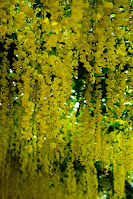 |
| Laburnum letyou seewhat Isee |
Haunting: Wisteria and Laburnum are just flowering… When I was as young as four and in the Reception class at my school (in a little enclave separate from the main buildings), a few of us shared a passion for these magical hanging blossoms. We would draw them over and over on a blackboard, and the strange thing is that I remember some very elegant sophisticated depictions - I wish I could see them now! The atmosphere that goes with these memories is very similar to the haunting ones of the ‘Rupert the Bear’ tales, or of fairy stories generally…
More young Starlings: There were about 75 Starlings on the grass in our local park– mostly young, with lots of chirring. I thought this was a good number, and hopefully an encouraging sign of their breeding success this year... They must gather together from quite a surrounding area?
 |
| Sabine’s Gull |
An expert friend said: ‘Lucky, lucky you!! Yes, Sabine's is very rare anywhere away from the classic watchpoints in Cornwall, Ireland, off the Scillies ferry etc, and you were so lucky to see a summer adult. I'm most envious.’
 |
| Young Tawny Owl |
Young Tawny Owl: My friend forwarded me this photo her neighbour just took of a confiding young Tawny Owl in their woods east of Cadbury Camp on Tickenham Ridge...
Fox Family: A friend was accompanying a client to a nearby health centre which has some extensive grassy grounds. As they waited they saw a Fox and three cubs playing on the grass right by their building - my friend did try to take photos but sadly medical matters intervened!
Wildlife Learning: Prompted by a post on our wildlife group showing plants, insects and fungi, I said how much I appreciate and how much I learn from posts like this. For instance, I don't feel capable of tackling the insect kingdom full on, but I do look up my unknown species listed in such posts - and something is retained in my memory! This is enriched by the data on time of year and local or regional habitats where these species have been found...
 |
| Holly Blue DBrooker1 |
First Holly Blue: I saw my first Holly Blue butterfly in our back garden today. Generally I see them in April (last year it was 6 April) so they are six weeks later this year – a reflection of how bitterly cold a lot of this May has been...
 |
| Botanists at Arlingham |
Arlingham Botany: A botany trip to this quiet isolated peninsula on the River Severn just north of Slimbridge, walking ‘across the isthmus’ from the south to north shores across often wet meadows. (Our leader was particularly interested in records revealing the limits of salt-liking, -tolerating or -disliking plants…) It holds small areas of saltmarsh which before reading Clive Chatter’s ‘Saltmarsh’ book I would have thought little of, but now understand are a precious declining habitat – these ones particularly appealing as free of Spartina grass, giving a fresh daintier appearance... Intriguing plants included the heavy-headed club-rush ‘Seaside Bulrush’; Sea Arrowgrass; carpets of flowering Sea Milkwort; Narrow-leaved Water-dropwort – a scarce plant ‘never recently been seen so far down river’; and an odd farmland escape of the Borage family – ‘Blue Tansy’, Phacelia tanacetifolia, grown as a green manure.

Spotted Medick seeds: At Oldbury Power Station we found some of the little Pea-family plant, Spotted Medick. Intrigued, I took a specimen home to study under a lens, and found that beside its small almost orange flowers, it has rather extraordinary round spiny seedheads, coiled into a neat spiral...
Bird walk at Ham Wall: We met on a beautiful warm day to tour this RSPB site adjacent to Shapwick Heath in the heart of the Somerset levels. It was restored from 20th century peat workings (starting in 1994), and designed to enhance or recreate an extensive habitat of rhines, lakes and reedbeds.
There was an almost continuous background of singing Blackcaps, excitingly interspersed with Willow Warbler and Garden Warbler, and Cetti’s almost too numerous to count… Whitethroat, Reed and Sedge Warblers, Song Thrushes and the occasional Chaffinch – what a soundtrack! We had a little master class on the Garden Warbler whose song sits squarely between the lush flutey fruitiness of Blackbird and the more manic Blackcap; with one member managing to record its song on a phone ID app which duly confirmed the ID…
 |
| Baby Coot Mark Bridge |
Beautifully marked male & female Marsh Harriers and one youngster hunted over the marshes, Bitterns boomed and skimmed across the reed tops, majestic Great White Egrets flew and settled, and Hobbies were seen high up, their dark scimitar silhouettes so similar to Swifts’.
 |
| Green Tiger Beetle Martin Reed |
Water birds were breeding: Mute Swans carrying youngsters on their backs; a tiny red-head-fluffed Coot on an island nest with smart older juveniles; Great Crested Grebe young with their humbug-striped head and necks; and Lapwings defending against predation, Shovellers bowing to each other; as well as many smart Pochards, scores of Gadwall, and a scattering of Tufted Ducks, Grey Herons and Cormorants. Bearded Tits and Garganey were there but not seen...
Green Tiger Beetle: A wildlife group member posted his photos of a Green Tiger Beetle. I thought it almost ridiculously beautiful, and commented that if it were a brooch it would be malachite and gold...
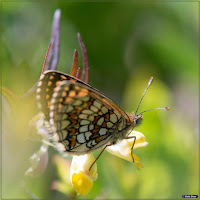 |
| Heath Fritillary Rob Daw |
Heath Fritillary: The same member posted pictures he had taken of the rare Heath Fritillary butterfly in Somerset – I though its hindwing underside was particularly beautiful... . I learnt that the Common Cow-wheat plant is its favoured food, and remembered the masses of the plant I had seen as I walked the woods down from Exmoor to Porlock last summer...
June
More Rewilding thoughts: My friend had watched a ‘Springwatch’ programme about rewilding efforts at Wild Ken Hill on the Norfolk coast. He said, ‘I hope something good comes out of re-wilding, but when you think that almost all of our most valuable wildlife habitats and species are there because of either traditional land-use practices like farming, grazing and coppicing or because of painstakingly focussed habitat management on nature reserves, it's gonna take a helluva long time for me to come round to the concept!’
 |
| Red-belted Clearwing Rob Emery |
Red-belted Clearwing: Another beautiful insect from our wildlife group members...
Portbury Wharf: There was quite a Warbler fest on the hedgerowed lane out to the saltmarsh, with Cetti’s, Chiffchaffs, Reeds, Blackcaps, Whitethroats and Lesser Whitethroats. Unusually we had excellent clear views of a Cetti’s showing its bright brown back and long, broad, rounded tail; and of a Lesser Whitethroat so smooth and neatly grey with an almost luminously pale underside...
 |
| Cetti's Warbler naturalengland |
The Buzzing of the Bees*… The bees are loud** in our next door neighbour’s towering pine tree – no doubt collecting resin to turn into their antiseptic wonder-compound propolis. And elsewhere in our garden the bees are loud and abundant – their sound as deeply soothing as a cat’s purr… Isn’t it strange how that buzz is so soothing to us, but a fly or mosquito’s is the opposite – I’m sure no-one in the history of humankind has commented on ‘the soothing buzz of the flies’… Species-specific responses to frequencies must be at work here!(For those who enjoy a musical/poetical reference - *‘The Big Rock Candy Mountain’ Depression-era song; ** W B Yeats ‘The Lake Isle of Innisfree’)
The ‘Invention’ of White Rot: My latest geology newsletter has an article describing the origin of lignin-eating White Rot fungus in the Permian period (after the Carboniferous). Lignin is the extremely tough part of wood which till then had been indestructable – so during the hot wet tropical Carboniferous the huge biomass of trees produced simply piled up un-rotted, and produced our great reserves of coal! But once White Rot appeared this could never happen again... Extraordinarily, modern scientists STILL don't fully understand how the fungus achieves this very difficult feat – you do have to applaud these mycological specialist species!
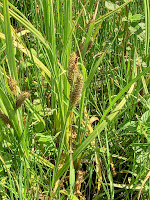 |
| Great Pond Sedge |
Botany trip to Bathampton Meadows Reserve: On an extremely hot day, we visited this private reserve on a large loop in the River Avon above Bath. It was developed as part of the Bathampton Bypass in the 1980s as flood relief and nature reserve, with shallow and deeper lakes from original farmland and graveled banks. Some of the plants we saw included (apologies for long lists!): Pyramidal Orchid, Common Spotted & Southern Marsh Orchids & their hybrids – some very large. Rosa Micantha with very pink flowers. Water Pepper. Amphibous Bistort. Celery-leaved Buttercup, Greater Spearwort, swathes of Common Meadow Rue. Marsh & Creeping Yellowcress, Scurvy Grass. Angelica, Giant Hogweed. Swathes of Common Meadow Rue. Ragged Robin. Brooklime, & Pink Water, Thyme-leaved & tiny Wall Speedwells. Red Bartsia, Water Figwort. Forget-me-nots: Water (big flowers!), Tufted (M laxa) and the tiniest Changing. Gypsywort . Purple Loosestrife. Hoary Ragwort. Quaking Grass, Yellow Oat-grass, Meadow Barley, Tufted Hairgrass. Brown, Greater Pond Sedge. Hard Rush, Common Spike Rush, Common & Grey Club-rush. Yellow Waterlily, Water Plantain, Lodden Pondweed, Pond Water-starwort, Azolla (a water fern), Stonewort. Wide paths carpeted with Birds-foot Trefoil…
 |
| Alder Leaf Beetles |
And of insects we saw: Narrow-bordered 5-spot Burnet, Blood Vein & Straw Dot Moths. Alder Leaf Beetles, 7-spot native Ladybird. Meadow Brown, Brimstone, Common Blue Butterflies. Odonata: Banded Demoiselles & Common, Red-eyed & White-legged Damselflies. Emperor, Black-tailed Skimmers, 4-Spotted & Broad-bodied Chaser Dragonflies.
Sharpness Docks... In these rather neglected small docklands up the Severn Estuary, were scores of Lesser Black-backed Gulls, their nests and their young on the corrugated wharfside shed roofs...
And the unusual Fleabane, Erigeron philadelphicus, was flowering in its particular patch on the way down to the canal...
 |
| Water-crowfoot |
 |
| Dryad’s Saddle |
Puxton Moor: Intriguing plants included Pale Persicaria - like a bolder Redshank with green rather than red stems, Amphibious Bistort, Celery-leaved Buttercup, White Water-crowfoot, Marsh Bedstraw and Lesser Water Parsnip. Like a Lotus Flower but on a tinier scale - the Water-crowfoot flowers are held aloft above the water on dainty stems, giving an impression of floating free… A superb Dryad’s Saddle bracket fungus - surprisingly it seems these very structural-looking fungi may only last a few days before insects destroy them… Many Small Tortoiseshell butterflies rising up from our feet as we moved through the meadow grass...
The Hive Mind: I said to a friend that being a member of our online wildlife group is like having a constant crash course in naturalist studies. He said it was demonstrating the hive mind in action... Me: ‘I see one definition of hive mind is: 'a notional entity consisting of a large number of people who share their knowledge or opinions with one another, regarded as producing either uncritical conformity or collective intelligence'... I do hope it's the latter...’ Him: Oh dear, yes - hopefully the latter. I'm not good at uncritical conformity!’
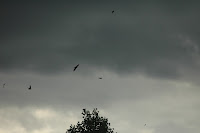 |
| Swifts stewyclaire |
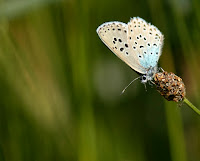 |
| Large Blue Butterfly Rob Dalziel |
Large Blue Butterflies: We drove to Collard Hill in the Polden Hills south of Glastonbury, to try to see the famous and rare Large Blue butterflies that thrive in this one particular spot. Through pure luck we had chosen one of the few suitable days for weather - still, clear and warm, and arrived early enough – the prime viewing time being from 9 or 10am to 11or 12 noon (and considering these butterflies only emerge for about three weeks a year, and then only a few show themselves at any one time – you have a relatively tiny number of hours to find them!). Again by pure chance, we were taken on by a butterfly photographer, who showed us the best spots on the south-facing slopes where the thyme blooms round the ants’ nests (though it’s been such a harsh spring that much less thyme than usual was in flower…). Many naturalists in the know were also there, and the slopes were full of behatted butterfly twitchers…
We
were lucky enough to see a lot of them -
but
I
admit it
was a different experience from what I originally, inaccurately,
imagined: ‘Huge,
bright blue butterflies sailing about the slopes…’ Though they
are indeed
the
largest British blue butterfly, it’s only by a marginal amount;
they
show themselves only quite briefly, and what is most visible is their
undersides which look darker than expected in flight; their
upper sides also have a thick dark border and the warm darkish blue
within only shows in brief flashes; they always perch with wings
closed, and
though
they
do have a paler blue flush at the base of the hind wing underside, I
just
couldn’t
make it
out… Nonetheless,
it
was still a beautiful and compelling experience!
 |
| Painted Lady naturalengland |
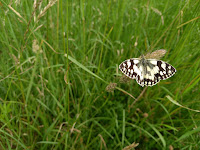 |
| Marbled White |
Catbrain Hill Meadows: I just managed to find this small reserve containing extensive ungrazed meadows, between housing and a big retail park on the west edge of Bristol - it’s near my home and places I’ve often walked, but so tucked away you could miss it every time! It was full of Five-spot Burnet moths – I saw twenty or more particularly on Knapweed and Red Clover; Latticed Heath moths; and Marbled White, Meadow Brown and Common Blue butterflies.
 |
| Five-spot Burnet |
I asked a man taking photos if he might be the member of our wildlife group who often posts pictures from this site – and he admitted that he was!
July
Herding Antiquity: We’d been bird watching along the Strawberry Line – the disused railway line, now a footpath, that used to carry strawberries from Cheddar to Bristol. As we walked back a farmer was driving a small herd of cows, calves and TWO bulls (one looking very young – learning the ropes perhaps?) along the path ahead of us, with the help of his family. He kept up a constant refrain of ‘Hai – hai – hai’, whistles and encouraging messages; and I thought – you could go back to the very start of humanity’s use of pastoralism, say 9,000 years ago and anywhere in the world, and you would have heard the same sort of herding cries…
 |
| Stiltbug D Bowring |
Stiltbug: A friend posted pictures of this Stiltbug, Metatropis rufescens that he’d found in Goblin Combe, and said it feeds on the plant Enchanter's Nightshade. Charmed by the leggy bug, I said it was welcome any time in our garden, where we always have lots of Enchanter’s Nightshade (whether we want it or not…). This is yet another insect family of which I was ignorant...
Squirrel antics: There were loud noises coming from across the street: from a Grey Squirrel plastered head down onto the pebble-dash wall half way down the house opposite…
 |
| even tinier Eyebright |
Haddon Hill: A bird trip to Haddon Hill, on the east side of Exmoor, where there's Redpoll, Siskin, Crossbill, Tree Pipit and more. We were shown the small area where the very rare Heath Fritillary butterflies gather, on a moorland slope including its foodplant Common Cow Wheat – though currently the site is too overgrown for this species…
Pretty heathland plants included Tormentil, Common Cow Wheat, Bell Heather, tiny Thyme-leaved Speedwell, even tinier Eyebright, and Lousewort. Oddly none of the miles of Gorse bushes seemed to be flowering...
 |
| Embankment grasses |
Littleton on Severn: The salt marsh was alive with Skylarks – one doing a perfect ‘Lark Ascending’ as it rose vertically to the heights in neat stages, singing throughout…
Along the embankment was a luxurious thick ‘fur’ made up of many grasses; bright flower heads of Curled Dock; even the humble Creeping Thistle making a bold display…
Trapped Gulls? Viewed from my car, there seemed to be dead bird bodies hanging from the Royal Mail building’s new roof nets. After consulting our gull expert and relevant wildlife charities, I notified Royal Mail – but never heard back...
 |
| Golden-ringed Dragonfly |
Golden-ringed Dragonfly: In Porthcothan, Cornwall, this beautiful Golden-ringed dragonfly landed on long grass right by our family party who were putting up my ‘accommodation tent’ in the garden; and it stayed there for almost an hour, allowing us to closely inspect and photograph it. Does that suggest it was newly emerged and 'firming up', or would it then have looked paler & more teneral-like? Our Odonata expert answered: ‘I think the way it's holding its wings over its back are suggestive of it being recently emerged. I also found an online picture of one drying out next to its exuvia, and it looked like the colours were similar to an older one.’
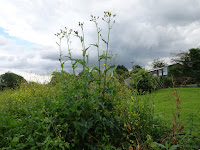 |
| Sonchus arvensis |
Sonchus arvensis: Have others noticed the extraordinary displays of Sonchus arvensis along the motorways? This lovely large, raggy, sunny member of the daisy tribe is growing straight up to considerable heights in long stretches and swathes. Here's some away from a motorway which had reached over two metres...
Bedroom Bat: I and a friend were staying in my niece’s riverside cabin above Upton on Severn. In the night a bat (species unknown) got into her bedroom and rudely woke her as it whizzed and banged about… but she managed to open enough doors to let it escape out again...
Midsummer Hill ash woods: I did an evening’s geology trip round Midsummer Hill which forms part of the dramatic southern end of the Malvern Hills. The climb up from quarries at the base goes through extraordinary woods comprising beautiful ashes of an enormous scale...
 |
| Sneezewort Swan Scot |
Lawrence Weston reserve: A (very hot) trip to the Lawrence Weston nature reserve, just east of the M5 motorway junction 18. I was surprised as previously I’ve only seen it in winter when it’s very rank and boggy, rather than displaying newly-mown hay meadows and lush reedbeds as yesterday.
Interesting and attractive plants included Knapweed, Sneezewort, Purple Loosestrife, Redshank, Water Forget-me-not with its bright little flowers, swathes of Tufted Vetch, fields full of Marsh Bird’s-foot Trefoil, Lesser Stitchwort, Pepper Saxifrage, Common Hempnettle with its spiky calyxes; and along the access lane - Lesser Burdock had grown to tree-like proportions. I was extra pleased as I hadn’t seen Sneezewort, Pepper Saxifrage or Common Hempnettle before...
 |
| Fool's Watercress |
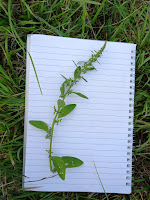 |
| Many-seeded Goosefoot |
Nailsea Moor botany: Nailsea Moor is inland from Clevedon. Many plants here are shared by the Fens, as they like a neutral PH habitat… Striking water plants included Marsh Bedstraw, Compass Plant, Gypsywort, Greater Birds-foot Trefoil, Creeping Jenny, Branched & Unbranched Burr-reed, Frogbit, Watercress, Fools Watercress (sprawling, smelling sweetly of parsnip, flowers coming straight from leaf axils) next to Lesser Water Parsnip (smelling sharply of parsnip, brighter green, ring marks on lower stem), abundant Water Docks, Reed Canary-grass, Greater & Floating Sweetgrass, Blunt-flowered Rush with splayed flower heads like molecule models, Remote Sedge, False Fox Sedge, flowering Water Plantain, & Arrowhead so abundant it’s choking the rhines! Fan-leaved Water Crows-foot, Water Violet (fern-like aquatic foliage only – but I’ve seen it flowering here in May), Marsh Horsetail with its bold black rings, Water Horsetail with its very fine-walled hollow stems, Hornwort, Water Starwort, Ivy-leaved, Greater & Small Duckweed, & Fringed Heartwort - a Liverwort that looks like Duckweed. And in the meadows were Scented Mayweed, Swinecress & Lesser Swinecress, Many-seeded Goosefoot, Common Bistort, and Vervain...
 |
| Toadlet |
We think a Grass Snake slipped into a rhine… And here’s a tiny Toadlet…
Odonata included Banded Demoiselles and Blue-tailed Damsel, Emperors and Common Darters…
 |
| Small Copper |
Butterflies & Moths included Red Admiral, Comma, Small Tortoiseshell, Small Coppers, Meadow Browns, Gatekeeper, Ringlet and Large Skipper; and Mother of Pearl and Small China-mark Moths...
 |
| Leaf Hopper |
Invertebrates included Dark Bush-cricket, Long-winged Conehead, Brassica Shield Bug, Thick-thighed Flower Beetle, Whirligig Water Beetles, Alder Beetle larvae, and the striking Leaf Hopper Lassus lanio...
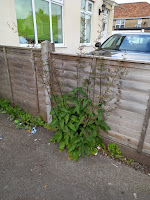
 |
| Nettle-leaved Bellflower |
End of the South Malverns: We returned to walk more of the South Malvern Hills before they finally die into the flat north Gloucestershire plains. We saw this Nettle-leaved Bellflower – a plant which I’ve previously only seen on the Sussex Downs... more magnificent huge Ash trees on the slopes... A Red Kite soaring over... and a Raven doing aerial flips...
August
Car-camping in Woody Bay: I went car-camping to North Devon in my new automatic car, starting with Woody Bay south of Lynton where the precipitous wooded cliffs that typify this stretch of coast, continue... There’s little car park at the top, with fantastic views north to the adjacent Valley of the Rocks, and to Wales across the Bristol Channel, with a 700 foot-plus drop straight down the wooded hill into the very rocky Woody Bay with its famed tidal pool which first attracted me, and which looks Olympic-sized online – but in reality is more of a paddling pool! Yet this obscure site with its demanding access was heaving with families, many with toddlers, dogs and gear, cheerily struggling up and down – you’ve got to admire the Brits! Rather ominously, a house half way down had a defibrillator on the wall…
 |
| Silver-washed Fritillary howzey |
The coast path rides were alive with huge flippety floating orange butterflies – not the more common Commas but rarer Silver-washed Fritillaries, like something from a South American jungle! A pair of bright Bullfinches were busy on large reed heads, and young Robins dominated the road edges…
...and round Barnstaple: I carried on south to an area I’d driven past but never explored before - the spectacular areas of beach, dunes, cliff, estuaries that includes the Tor-Torridge estuary, Staunton Sands and Braunton Burrows and Marsh – all just out from the town of Barnstaple.
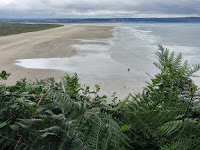 |
| Staunton Sands |
. Staunton Sands: I walked these three miles of spectacular pure sand beach and surf edged with high dunes, Lundy Island out to sea with Swansea Bay and the Gower peninsular beyond… Once I’d left the car park, surfers and swimmers behind I had the beach edge to myself… Dunlin and Ringed Plovers scampering with Oystercatchers and Curlew… At one point just the bottom of a thick rainbow curved north from cliffs beyond Clovelly, while simultaneously shafts of strong light through dark cloud angled over it the opposite way – making a dramatic crossed motif…
 |
| Angelica |
. Braunton Burrows: Behind the beach is the largest dune system in England, partly preserved by military use, covered in natural carpets of closely-cropped Thyme, Vipers Bugloss and Restharrow, and Evening Primrose and Ragwort standing tall and yellow...
 |
| Dodder |
. Braunton Marsh: And inland behind the dunes is this swathe of historical marsh, preserved as it was from Victorian, and in some areas - Mediaeval times, rich in plant and animal life... Rich rhine-side bouquets of Fleabane, Yarrow, Corn Mint, Common Hemp-nettle – and a statuesque purple Angelica…… Swathes of flowering Curled Dock had left rivers of their dark rust seeds flowing along the roadside… It’s bordered bythe Taw-Torridge estuary - a lovely quiet winding sandy estuary going up to Barnstaple and fringed with bird and wildlife reserves (but guarded at its entrance with what my sailing friend tells me is possibly the most dangerous sand bar in the country...) Many lovely birds but my best was a gorgeous Redpoll, his forehead and chest of an almost fluorescent orange hue - I hadn't seen one for years and never one as bright as this...
. Plants on the Staunton to Croyde coastpath: - The parasitic filaments of Common Dodder made this Gorse look like a hairy cacti - or perhaps a yak? While its flowers truly are like decorative beads strung at intervals along a dainty thread…
 |
| Hawkweed |
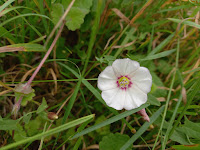 |
| Field Bindweed |
- Another Field Bindweed with a central ring, in a small patch withonly non-ringed specimens beyond (the only ones I’ve yet to find apart from at Marshfield).
- Tree Mallow, and new to me - Sea Rocket and Hoary Stock, typical for this area and habitat...
- Hawkweed: I also brought back my first successful specimen of the Hawkweed (Hieracium) tribe, a surprisingly elusive group beyond the common Autumnal Orange, and which like a warm slightly cliffy habitat – tentatively ID’d as Glabrous-headed...
Mandarin Ducks: On the lake above Clapton in Gordano - nine Mandarin Ducks including juveniles with adults in eclipse - the males’ extravagant orange ‘Elvis sideburns’ currently reduced to a grey fluff…
 |
| Magpie & Gull |
Filton urban wildlife: A young Magpie jostling for scraps with a Black-headed Gull in our local supermarket car park - its head still sparsely feathered, giving that 'pterodactyl' look... and a Holly Blue butterfly on vegetation bordering the busy main road...
 |
| Emperor |
Emperor emerging: I took part in an Odonata field day in Bristol’s Botanic Gardens. As well as searching for dragon and damselflies, we were shown an extraordinary film made by one of the tutors, edited from the 4 ½ hours it took for an Emperor larva to climb onto a reed, grip its larval claws firmly in place, split its casing skin and start to pull itself through the gap… then rapidly enlarge to twice the size of the original casing as it inflated itself, then fluttered its wings – finally taking its first weak flight...
Grasshoppers: I was mowing the back garden lawn, and for the first time that I can remember there was an abundance of grasshoppers jumping out the way...
Fox & Fruit: A few years ago I was growing strawberries rather unsuccessfully in a raised bed. One morning I woke early to see a young fox delicately plucking and eating the strawberries… From then on I netted the bed (though my fruit haul didn’t improve that much!).
Now a few weeks ago I had a bush full of almost ripe blackcurrants. I went away for a couple of days, but on my return I found the bush completely and thoroughly stripped. This time I put it down to Wood Pigeons whom I’d seen hanging about…
Also this year I’ve had a young Victoria Plum tree laden down with fruit… yet recently the number of plums was reducing. Then this morning I went to inspect it: the plum count had reduced yet again, and on the adjacent path was: fox poo and plum stones.
So now I’m thinking – had the fox taken the blackcurrants too?
 |
| Small Teasel |
Small Teasel: I visited my family at Hatherop School east of Cirencester, where my niece and husband held their annual Adventure Travel Film festival this year. Strolling round the edge of the encamped bikers, I saw an impressively stately plant I didn’t recognise. I was a bit chastened when it was identified as a Small Teasel – a plant I’ve been shown a few times before. In justification I said: ‘I think I must have previously only seen poor or immature specimens in the field, and not understood what their mature architecture can be. And I have very much underestimated how small and round the flower heads are, or how big the whole plant can grow!’
Odonata at Craven Arms: I travelled over 100 miles each way to attend an Odonata day course with field experience, in Shropshire. Field courses are as rare as hen's teeth, and even those that had been advertised kept being cancelled due to Covid - so Shropshire seemed comparatively local compared with this year's alternative in Suffolk! The problem being, that Dragonflies are so very fussy about the weather and the temperature!
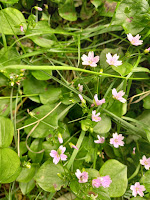 |
| Pink Purslane |
Pink Purslane: As we were looking for Odonata, I saw this plant that I thought might be related to Bog Pimpernel – but apparently it’s Pink Purslane, a plant that even our botany expert says he hasn’t seen in the wild...
Toad: I found a well-grown toad in our back garden just now. I disturbed it with my weeding and it jumped onto the vertical fence face – but was gone by the time I returned with a camera That’s the first toad I’ve seen here for many a long year, though they used to be regulars in our compost heaps - so that’s encouraging!
 |
| Hoverfly |
Hoverfly: My friend posted this Ferdinandea cuprea which he said has always been his favourite Hoverfly - ‘Luckily it seems to be doing well and I've seen loads this summer. This one was at Avon Gorge.’ I asked if it was the humbug-striped thorax that so pleased, and he replied‘Yes, plus the spots on the wings - but the best thing is the shiny, brassy abdomen with a yellowish border - I'm in love!’
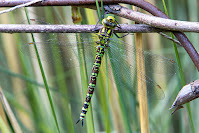 |
| Southern Hawker |
Back garden Southern Hawker: My word – our back garden has just been visited by a mature female Southern Hawker, green & yellow stripes and amber-tinted wings visible as she cruised around – and so BIG! This is the first Odonata I’ve ever seen round here...
 |
| 'Entangled Life’ |
'Entangled Life’: I have just finished reading 'Entangled Life - how fungi make our worlds, change our minds and shape our futures' by Merlin Sheldrake, a great book full of important things. I was particularly struck by how fungi make it their life's work to see if and how they can eat anything - how incredibly ingenious, and how potentially useful to us to correct our horrible polluting ways... And how they are intertwined through everything…
A wildlife member added, ‘The book explains symbiotic relationships between fungi, plants and trees many of which are host specific. This is often key to better species identification of not just trees, plants and fungi but also host specific insects. It explores the interactions between species / kingdoms and how and why they are connected, often dependent on a chain of natural events for their existence and survival...’
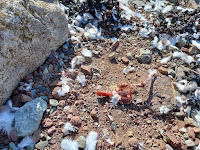 |
| Carcass |
 |
| Folded geology |
A successful bird kill – leaving a thoroughly-picked carcass...
Frogbit leaf marks: Our botanist wrote, ‘In the Sharpness marina last night I found Frogbit. It has really odd leaf veins, as if there was an impression of the bottom of a coffee cup on a small water lily leaf.’ I look forward to seeing this for myself...
Slime Moulds: I was sent a good article on Slime Moulds - another group similar to Fungi whose members have extraordinary lives... It reinforces the message of 'Entangled Lives' that we urgently need to know, understand and appreciate more about our unicellular and microscopic friends, in order to fully understand the lives of larger creatures...
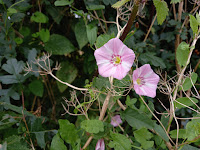 |
| ‘Forma pentastictus’ |
‘Forma pentastictus’: Walking a quiet lane near Chipping Sodbury Common, I ‘accidently’ found my third Field Bindweed with the pretty central ring (the variety called ‘forma pentastictus’). I hadn’t even noticed when I took the photo – I only realised when I uploaded it at home!
September
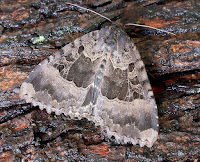 |
| Old Lady |
Fox & Cat: A birding friend who lives near the edge of Blaise Estate, Bristol, recently viewed the following: he’d put out some scraps for local foxes, but a cat got there first and actually chased the fox away… until sneaking up behind, the fox managed to give the cat’s tail a nasty nip and the moggie ran for it…!
Old Lady: An older female moth-ing friend posted ‘A photo of a rather disheveled Old Lady from last night’s trap.’ I bantered ‘...and of some moths too!’ for, as another old lady, it's hard not to make double entendres from such comments. (Of course you need to know an Old Lady is also a Moth species...)
 |
| Pellitory of the Wall |
Pellitory of the Wall: Along Henleaze High Street where I take Pilates classes, abundant Pellitory of the Wall was suddenly sprouting at the junctions between shops and pavement... This plant has one of my favourite common names, and I also think it is a modest yet elegant and graceful plant, with leaves that feel delightfully soft yet finely firm. It's in the Nettle family and one can sort of see a resemblance…
 |
| Fool’s Parsley |
Fool’s Parsley: I have found self-seeded Fool’s Parsley in my back garden - a pretty little umbellifer which nonetheless is very poisonous! It took me a while to identify (I’ve only seen it once before): ‘The main identifying feature are the long narrow and linear bracteoles which hang downwards from the umbellets’. Our botanist observed: 'The book on British Poisonous Plants says it emits a repulsive odour, which becomes more marked when crushed or bruised.' In the interests of science (and possibly being a fool…) I have just crushed and bruised my specimen and inhaled, but am getting little more than a sappy odour...
 |
| Conyzas |
Conyzas at the Water Park: There’s an open-air swimming lake near us, displaying a fine stand of Conyzas (Canadian-type Fleabanes) in the ramshackle parking areas. I plucked some leaves to identify the species from the leaf-edge hairs, as Conyzas canadensis, floribunda and sumatrensis each have a different hair ‘style’. With some help I identified all three species – the first time I’ve found them growing together like this.
Galls: I am currently reading ‘A natural history of the Hedgerow’ by John Wright. He observes that ‘Galls can be formed by insects, bacteria, fungi, nematode worms and even other plants…’. I never realised so many life forms could be involved in what is basically the creation of home or nursery for the creatures involved...
Weston
Moor:
A walk into Weston Moor - an
inland moor between Portishead and Clevedon with rhines, wet meadows,
woodland and a small lake, entered through a
Model Aeroplane Club grounds.
Moorhens and Mallard on the rhines; on
the lake - confusingly
eclipsed Gadwalls, Teal and Mallard, a Little Grebe and Grey Heron
and
Gulls
coming down for vigorous bathes. In the skies, a
young
Buzzard meeping, a briefly
glimpsed
Hobby scything across the sky, Ravens and
House Martins. In the
woods,
hedgerows and fields were
Jays, Great Spotted Woodpecker, fine male Kestrel perched, a
Cetti's Warbler, Chiffchaff and Reed Warbler, streams of Long-tailed
Tit, a beautiful male Whinchat sitting up on a hedge, and
a
Wheatear resting and pottering on the grass… and
a
Roe Deer.
There was sky blue Chicory flowering on the Club’s field edges (‘Chicory can remain faithful to a site long after it was grown as a crop, or planted for ornament’), and a Hedge Bindweed flower showing a ring of neat holes round its petals where some invertebrate had chewed in at the bud stage...
 |
| Common Darters along grid |
Common Darters: In a woodland glade at Tickenham, Common Darter dragonflies were perching all along this stretch of metal grid – 6 or 7 at a time!
Marshfield back roads: Some lovely Comma and Speckled Wood butterflies: one Comma flew fast across the road to land by my shoe… There was a constant humming of bees – all seemingly coming from abundant Ivy in flower… (video).
Apocalypse Now: I returned to Pilning Wetlands, accessing its side lane from the inland fields, as the estuary side is firmly closed by ever more intimidating fencing. At the lane end I barrelled through gaps under the fences (using my version of commando rolls...) onto the depressing and unsightly chaos that is the new embankment works – and because the farmer was burning the vegetation edging the pools, the resulting smoke added to the impression of entering Apocalypse Now… None of this was conducive to tranquil bird watching...
 |
| Guelder Rose |
Glowing: At Oldbury Power Station - a glowing Guelder Rose, and a Wayfaring Tree showing its velvet ‘fawn ear’ buds...
 |
| Road Grid |
Road Grid: In the road outside Tickenham’s church, I was amused by this charming naturally-planted cast-iron grid!
Webs: I am full of admiration for web-weaving spiders at this time of year – even if they do spin across every path and gateway one wants to pass through! Often their main anchoring lines can stretch four or five feet or even more, to the outpost of another shrub or post…
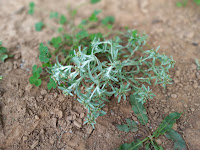 |
| Marsh Cudweed |
Botany below Pill: We went botanising to the saltmarshes where the River Avon enters the Severn Estuary. Plants of note included: bright deep green Sea Pearlwort with its long flower stems; a Buckthorn tree with a weeping habit; Sea Club-rush showing orange from a distance against the all-pervading glaucous Sea Couch-grass; Sea-blite, Sea Milkwort, the Saltmarsh Rush, Greater Sea Spurrey with dainty foliage and white flowers (when you look at its tiny black seeds in a lens, they have a beautiful bright halo round them…), and Wild Celery that really looks and smells like the cultivated vegetable… Into a large area of spoil and along a rough hedged path were smart
 |
| Sea Pearlwort |
Oxford Ragwort, various Fumitories, Marsh Cudweed, Goosefoots including Multiseeded, Fig-leaved and Red (the latter not red at all!), a rosette of flowering Dwarf Mallow, Centaury, Yellow-wort, Blue Fleabane, Annual Mercury, Dwarf Spurge, Smooth Tare (with pairs of
 |
| Rough Hawkweed |
October
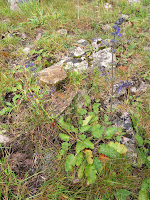 |
| Wild Clary |
Wild
Clary:
On
a geology trip to Tortworth
(north of Bristol), we
crossed a
dry calcareous rough pasture field just south of Tortworth Lake,
that
was full of the
uncommon Sage
plant Wild
Clary. I’d
never seen it before and was excited to see swathes of it – tall,
strong and handsome, with vibrant deep purple-blue flower spikes...
 |
| Common Darter |
Box-fresh: At Oldbury village, four box-fresh Red Admiral were all together on a bramble bush, with three Common Darters sunning themselves on a picnic bench…
Voles & Spiders: Seen on a botany trip to Lawrence Western Nature Reserve:
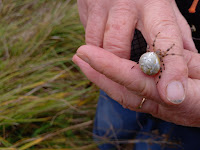 |
| Four-Spotted Orb Web Spider |
Water Voles: - Local rangers showed us the sanitary arrangements of Water Voles – generally scarce and declining aquatic rodents who encouragingly appear to have a large population here. First in the middle of a tussock, a communal toilet which from its large 20cm diameter indicates years of use by many voles! Then on a floating piece of wood, some individual poos – apparently they love a raft for personal toileting… We also saw reeds gnawed neatly at 45 degrees, another Water Vole sign. However along the very overgrown rhines and small pools we could discern no obvious burrows, tracks, or passages through duckweed...
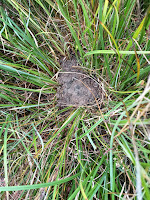 |
| Water Vole toilet |
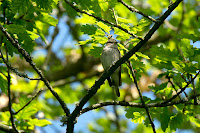 |
| Spotted Flycatcher |
Spotted Flycatcher: On a beautifully warm still day on a wooded stretch of the coast path above Clevedon Harbour, I had a brief but clear view of a small bird’s rayed streaked breast and knew it for a Spotted Flycatcher – one of the few times I have confidently named this quietly pretty summer migrant! Though comparatively late to still be here, others confirmed they were still being seen before their departure for Africa...
Squirrel takeover? A few days ago a Grey Squirrel was at our Filton patio door, and later two were atop the roof of a two-storey terrace house opposite. Then yesterday I saw three on that same roof - playing together which suggested they were a family group, and maybe had found a way into that house’s attic space? Generally we can go for years without seeing squirrels here, and I’ve never seen more than one at a time before...
 |
| Orange Hawkweed |
 |
| Ailsa Craig, SW Scotland |
Scotland sights: A six-day geology trip to the south-west of Scotland was my first group ‘away’ trip for two whole years – all others having been cancelled or postponed. As geology and bird trips are my favourite holidays, that’s been a great loss and this was a great pleasure! The geology was exciting, the wildlife perhaps less so, but memorable vignettes included: Five Black Guillemots in their pretty pale winter plumage, in the harbour of the pretty little town where we were based… Great flocks and rafts of Mute Swans in Stranraer Lock… Abundant Oystercatchers and Curlews happily foraging in fields with sheep, right by the main road through Ballantrae… And masses of flying Jackdaws murmurating over a wild beach…
 |
| Weasel |
Weasel: On the path towards the Sewage Treatment Works south of Weston - a weasel darting back and forth…
November
Braunton: This was my second group trip away: inspired by my summer trip here, I’d booked our small bird group into a smart self-catering house for four days of birdwatching around the Taw-Torridge Estuary...
Fremington Quay: Looking from the high quay of this disused railway station on the wide southern edge of the estuary, we had lovely views down onto about 150 Black-tailed Godwit feeding frantically in the mud below - black tails wonderfully visible - then flying out to nearby sandbars for a great wash and preen - then back to feed again... and two Kingfishers flashed across them...
Fremington Pill: At a late afternoon’s high tide along this small river winding down to the Quay, we twitched for a Glossy Ibis and found it perched high in a tree overhanging the river with lots of other roosting Little Egrets. Initially all one could see was just a hunched black ball of feathers on two knock-kneed legs, like a Tenniel drawing from a Lewis Carroll ‘Alice’ book... (However, the Spotted Redshank remained elusive...)
 |
| Skern Bay |
Northam Burrows, Skern Bay: Further south past Bideford on the Torridge estuary mouth, this flat area of dune, shingle, moor and marsh held wonderful flocks of Brent Geese, Pintails and Golden Plover, with a handsome Great Northern Diver in so close we could study its black-and-white plumage patterns in detail… and the Pintail females’ distinctive smooth pale golden-brown heads and necks… (However, Snow Buntings along the shingle beach and Eiders out to sea – remained elusive…)
 |
| Hartland Point Alan Sykes |
Hartland Point: We did a day trip to wild rocky Hartland Point where the North Devon coast turns steeply down… We had come to twitch a Red-necked Diver at sea, but this remained elusive as did any other pelagic birds at all - not even a Gannet could we find along this stretch of coast! But climbing to the top of the Point, we were next to a crag full of Ravens where a Peregrine made a heart-stopping stoop from the skies to the sea; and with loud honks three magnificent Whooper Swans flew over our heads, great long necks outstretched, before turning back to the safety of land again...
 |
| Sanderlings |
Saunton Sands: On our last day we returned to this magnificent three-mile stretch of beach and dune. There were about 100 Sanderlings scattered along the beach, heads down to probe the sand and gliding (or perhaps ‘glissading’ in StrictlyComeDancing parlance…) so amazingly fast and smoothly that they could have been on castors... Apparently they only have three toes with no back claw, and this contributes to their fascinating gait... Their diet is small inverts grabbed in shallow waters or along the surf edge, and their hunched posture as they search contributes to their endearing appearance of always being a bit worried…
Great Spotted Woodpecker: A Great Spotted Woodpecker was foraging in next door but one's very overgrown back garden with its overhanging apple trees. This was a definite first for me, and gave a pleasant sense of Filton being a more rural place once more (It was only in the late 1920s that this outer Bristol area was built up to house the workers at the brand new ‘Bristol Airoplane Company’ down the road - now of course the home of Airbus, Rolls Royce and other aeronautical giants...)
 |
| Wall Poo |
Wall Poo: Along the length of a new kilometre stretch of concrete sea-defence wall south of Severn Beach, was an almost continuous scattering of (presumed bird) poos containing seeds (mostly hawthorn I think). I’m guessing a flock of well-fed Starlings perched along here? Any other suggestions?
Cold Marshfield: I went to this high Cotswolds area on the first brilliantly cold northerly day of this late Autumn, where right in cue with falling temperatures, large bird flocks had started to amass – around 1200 Woodpigeons in a stubble field, 70 Fieldfares and 160 Redwings, 90 Rooks, 17 Common Gull, and about 130 Starlings high in the beech trees by Kington Farm, softly sussurating…
 |
| Common Gull foxypar4 |
Common Gulls at Hawkesbury Upton: Around this Cotswold village, we had the pleasure of extensive fields full of Common Gulls, most in their superb adult winter plumage, and many close enough to easily study their characteristics – dark eyes, greenish legs and small bill, pale-brown streaked heads, lovely black-&-white patterns on wing tips, (including the white ‘mirror’ spots like Herring Gulls). Larger than Black-headed Gulls, they have a similar grace and agility in flight and a general elegance... One oddity was a juvenile perched on a house rooftop showing its dark bill tip – I’ve not seen this species in an urban setting before, or perched!
 |
| Golden Plover Rob Hargreaves |
And a lone Golden Plover in an adjacent field...
Late Autumn Colours: Hedgerow Cranesbill & Field Madder were flowering brightly in arable fields at Hawkesbury Upton, and a fine
 |
| Field Madder |
skein of Briony berries draped in woods outside Congresbury...
Life: A friend sent me a very pessimistic poem about current life on this planet. I do find a perspective of gloom and doom solely from a human viewpoint is unbearably depressing. Surely the magic and preciousness of life and living and what just exists, is infinitely more than what us wise-yet-foolish humans are up to? If our species goes extinct and half-ruins this planet in the process, no way will it extinguish life altogether, or the infinite possibilities of the universe...
 |
| Briony berries |
December
Woods & Fields: Round Marshfield on a bright, cold day - a flock of about thirty Skylark with Meadow Pipits, Corn Buntings and Yellowhammer in the fields, and Goldcrest, Nuthatch, Treecreeper and Chaffinches in the woods...
Ingst Survey: My 'Early Winter Bird Survey' at Ingst today in cold, bright, calm weather, netted 26 species. This was the first time I've recorded Little Egret, Peregrine or Long-tailed Tits, demonstrating yet again that there's nearly always something new and interesting to be recorded!
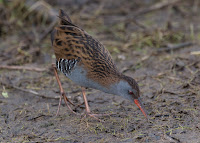 |
| Water Rail |
Portbury Wharf: A surprising total of 50 species on a bird walk at Portbury Wharf included Shelduck, Shoveler, Gadwall, Wigeon, Mallard, Teal, Water Rail (in the landward ditch to the salt marsh embankment... ), Lapwing, Curlew, Cormorant, Grey Heron, Sparrowhawk, Barn Owl (in the neglected barn on the far left end of the access lane, pale body flying out and away when too many of us stared at it…), Great Spot and Green Woodpecker, Kestrel, Song Thrush (singing a brief snatch of melody... )and Mistle Thrush, Stonechat, Chaffinch, Bullfinch, Greenfinch, Linnet and Reed Bunting...
Moth Names: Because I am so enamoured of their names, I keep a list of the Moths annually reported on our wildlife group. For those who might enjoy them, here is 2021's list - and what a vivid visual picture they paint! A friend said, ‘I love how so many moth names reflect the lost world of genteel 18th and 19th century English society when these insects were described - wainscot, footman, engrailed, annulet, brocade etc - deliciously evocative of a past age.’ And that's very much how I experience them - the furnishings, the servants, the bucolic countryside...
Angle Shades, Mullein Moth, Lesser Yellow Underwing, Swallow Prominent, Oak-tree Pug, Puss Moth, Pale Tussock, Green Longhorn, Drinker Moth, Burnished Brass, Shaded Broad-bar, Brussels Lace, Clay, Swallowtail, Shaded Broad-bar, Kent Black Arches, Brown Scallop, Rosy Footman, Dingy Footman, Least Carpet, Four-spotted Footman, Buff Ermine, Oak Eggar, Knot Grass, Mint Moth, Gypsy Moth, Straw Underwing, Riband Wave, Silver Y, Square-spot Rustic, Heart and Dart, Lesser-spotted Pinion, Alder Moth, The Tissue, Yellow-barred Brindle, Red Underwing, Old Lady, Clifden Nonpareil (Blue Underwing), Radford’s Flame Shoulder, White-point, Small Ranunculus, Small Square-spot, Common Wainscot, Large Yellow Underwing, Setaceous Hebrew Character, Square-spot rustic, Brimstone, Box Tree, Marveille du Jour, Barred Sallow, Beaded Chestnut, Orange Sallow.
 |
| Dead Hare |
Dead Hare: Driving to Oldbury Power Station, we thought we’d passed a young Fox with golden and white fur, dead by the roadside and being scavenged by a Magpie. Planning to photograph it on our return, I got out with my camera - and saw it was not a Fox but a Hare. Dead or alive, I’ve never seen one so close before except in a butcher's shop... what lovely lovely animals they are…
 |
| Dancing Willows |
Dancing Willows: These willows lining the path behind Easter Compton seemed to dance like beautiful maidens...
Bullfinch flock: In small trees at Oldbury - a flock of five Bullfinches bright amongst the twigs; it’s been years since I last saw this beautiful winter phenomenon… And Dogwood thickets with new red shoots emerging from the chartreuse-coloured lichen-covered older growth...
 |
| landham_birder |
